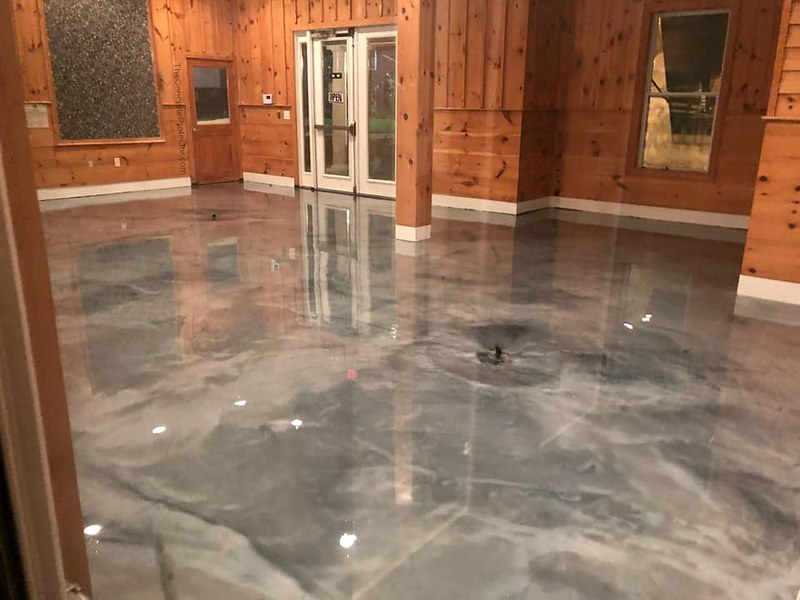Polymeric flooring
Metallic marble epoxy flooring from Creative Concrete Coatings.
[edit] Introduction
The term ‘flooring’ refers to the lower enclosing surface of spaces within buildings. This may be part of the floor structure, such as the upper surface of a concrete slab or floor boards, but typically it is a permanent covering laid over the floor. There are many types of flooring materials available. For more information see Types of flooring.
Resilient flooring is loosely defined as flooring manufactured from elastic materials. Products made out of these materials share certain characteristics - they are durable and firm, but they also offer a degree of 'bounce' or resilience. For more information see Resilient flooring.
[edit] Polymers and flooring
One type of resilient flooring is polymer. A polymer is a substance which has a molecular structure built up chiefly or completely from a large number of similar units bonded together. In basic terms, polymers are very long molecules typically made up of many thousands of repeat units.
Many synthetic and organic materials are based on polymers, including; plastics, rubbers, thermoplastic elastomers, adhesives, foams, paints and sealants. Polymer materials account for the highest growth area in construction materials. Well-established applications of polymers in construction include products used for flooring, windows, cladding, pipes, membranes, seals, insulation, and so on. With thousands of commercially available polymers new applications are emerging all the time.
Polymeric floors are poured as liquids and spread out across surfaces to harden and cure. This creates a finish without seams and makes them particularly suitable for industrial or commercial applications.
Examples of polymer materials in flooring include:
- Epoxy flooring (including solid resin and terrazzo flooring) is a combination of polymer resins and hardeners that form a single cohesive material that is at least 2mm thick (otherwise it is known as epoxy coating). It is not only durable but can also cope with harsh usage. It increases the strength and durability of concrete and protects the floor from chemicals. It can also increase the light reflectivity of the floor and bonds easily with cement or concrete.
- MMA (methyl methacrylate) resin flooring is a dual system polymer able to withstand weak acids and other solvents. Epoxy has a gentler cure rate as compared to MMA (methyl methacrylate) floors, and it requires more than one coat to remove porosity of the concrete.
- Urethane (and urethane concrete) flooring systems (also known as polyurethane flooring systems) are used to treat concrete floors and enhance their chemical, water, slip and abrasion resistance.
The introduction of polymeric materials has brought with it new concerns, particularly relating to their longevity, how they are affected by ageing and weathering, the effects of pollution, environmental and sustainability issues, fire performance, re-use, recycling or disposal at their end of life and so on.
[edit] Related articles on Designing Buildings Wiki
Featured articles and news
Construction Skills Mission Board launch sector drive
Newly formed government and industry collaboration set strategy for recruiting an additional 100,000 construction workers a year.
New Architects Code comes into effect in September 2025
ARB Architects Code of Conduct and Practice available with ongoing consultation regarding guidance.
Welsh Skills Body (Medr) launches ambitious plan
The new skills body brings together funding and regulation of tertiary education and research for the devolved nation.
Paul Gandy FCIOB announced as next CIOB President
Former Tilbury Douglas CEO takes helm.
UK Infrastructure: A 10 Year Strategy. In brief with reactions
With the National Infrastructure and Service Transformation Authority (NISTA).
Ebenezer Howard: inventor of the garden city. Book review.
The Grenfell Tower fire, eight years on
A time to pause and reflect as Dubai tower block fire reported just before anniversary.
Airtightness Topic Guide BSRIA TG 27/2025
Explaining the basics of airtightness, what it is, why it's important, when it's required and how it's carried out.
Construction contract awards hit lowest point of 2025
Plummeting for second consecutive month, intensifying concerns for housing and infrastructure goals.
Understanding Mental Health in the Built Environment 2025
Examining the state of mental health in construction, shedding light on levels of stress, anxiety and depression.
The benefits of engaging with insulation manufacturers
When considering ground floor constructions.
Lighting Industry endorses Blueprint for Electrification
The Lighting Industry Association fully supports the ECA Blueprint as a timely, urgent call to action.
BSRIA Sentinel Clerk of Works Training Case Study
Strengthening expertise to enhance service delivery with integrated cutting-edge industry knowledge.
Impact report from the Supply Chain Sustainability School
Free sustainability skills, training and support delivered to thousands of UK companies to help cut carbon.
The Building Safety Forum at the Installershow 2025
With speakers confirmed for 24 June as part of Building Safety Week.
The UK’s largest air pollution campaign.
Future Homes Standard, now includes solar, but what else?
Will the new standard, due to in the Autumn, go far enough in terms of performance ?
BSRIA Briefing: Cleaner Air, Better tomorrow
A look back at issues relating to inside and outside air quality, discussed during the BSRIA briefing in 2023.
Restoring Abbotsford's hothouse
Bringing the writer Walter Scott's garden to life.
Reflections on the spending review with CIAT.


























